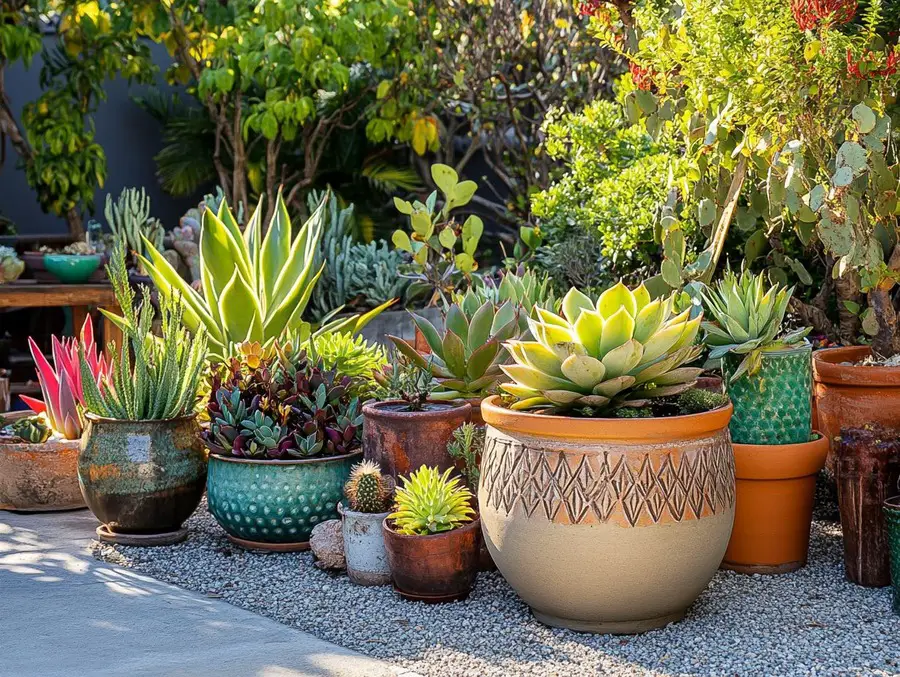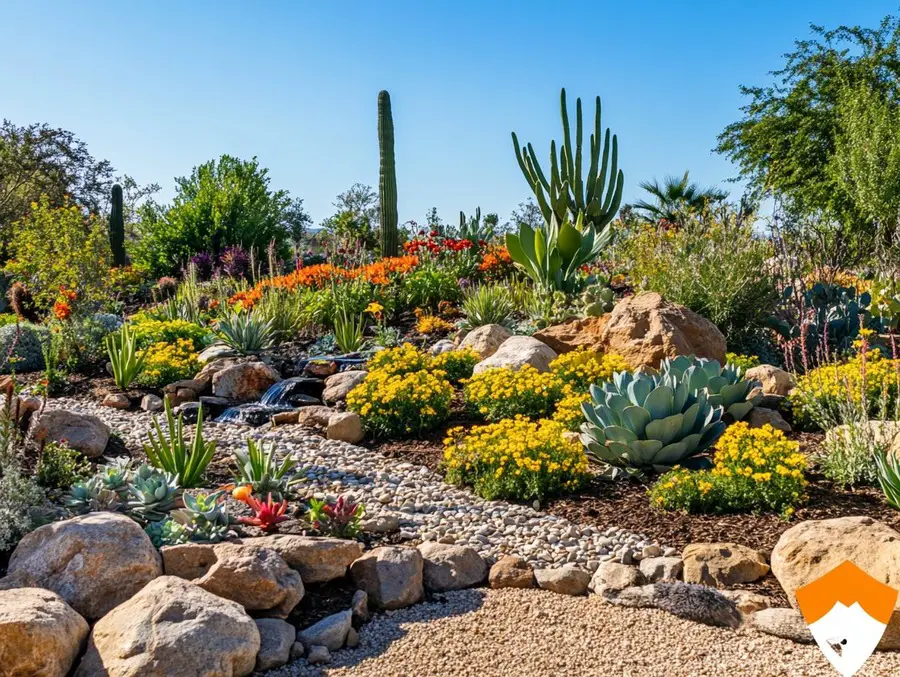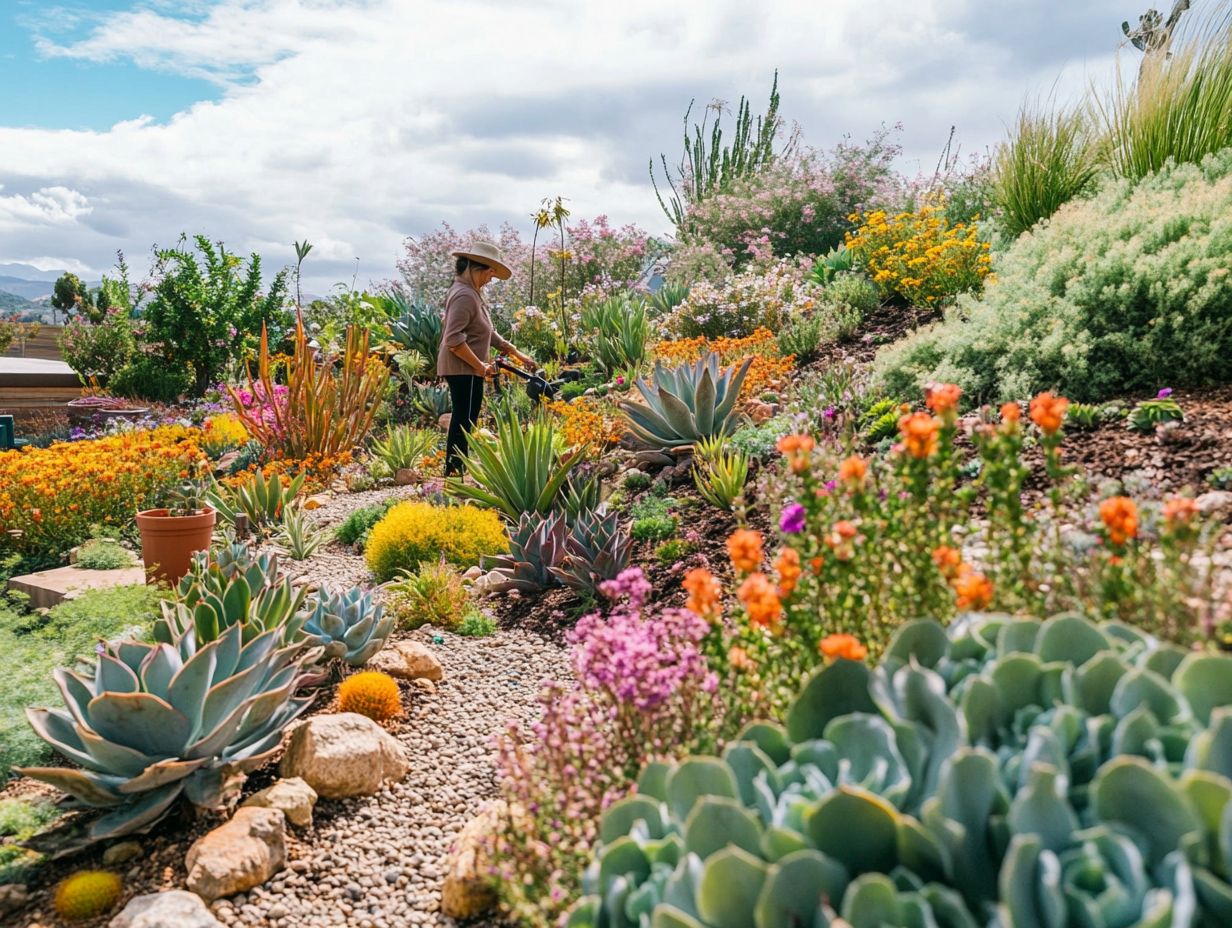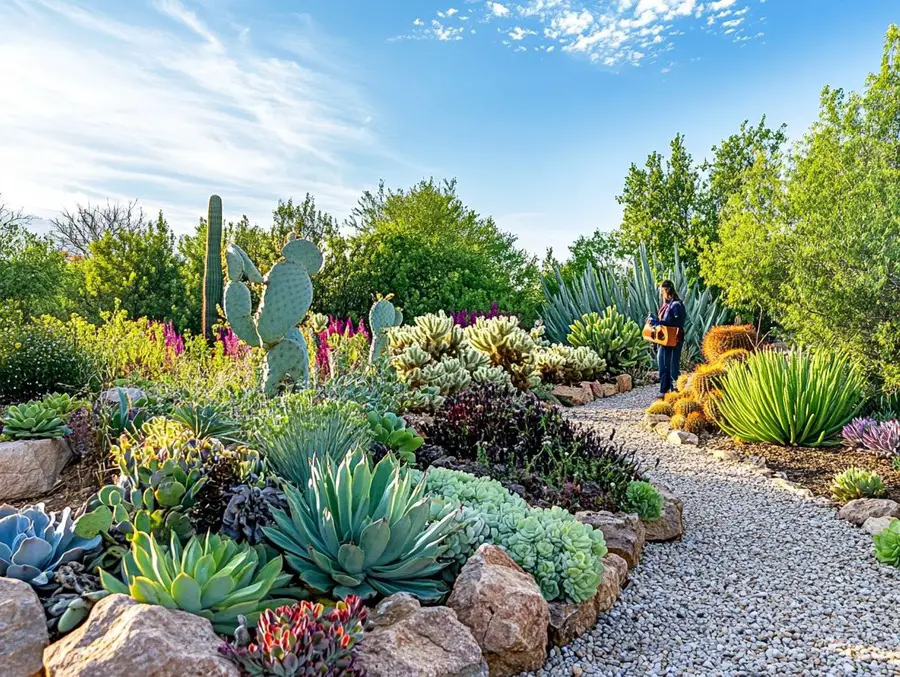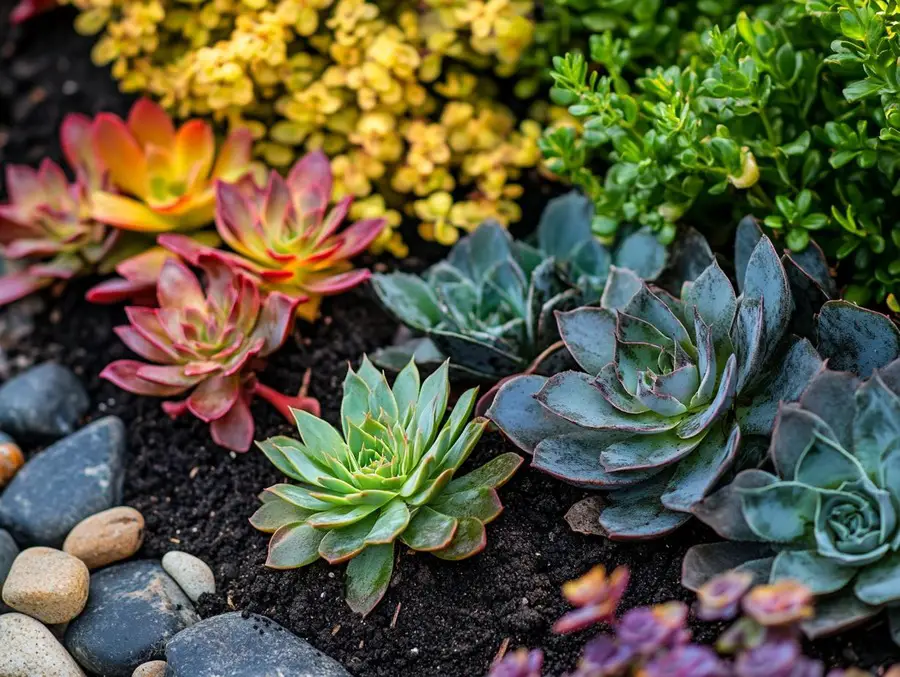We use affiliate links. If you purchase something using one of these links, we may receive compensation or commission.
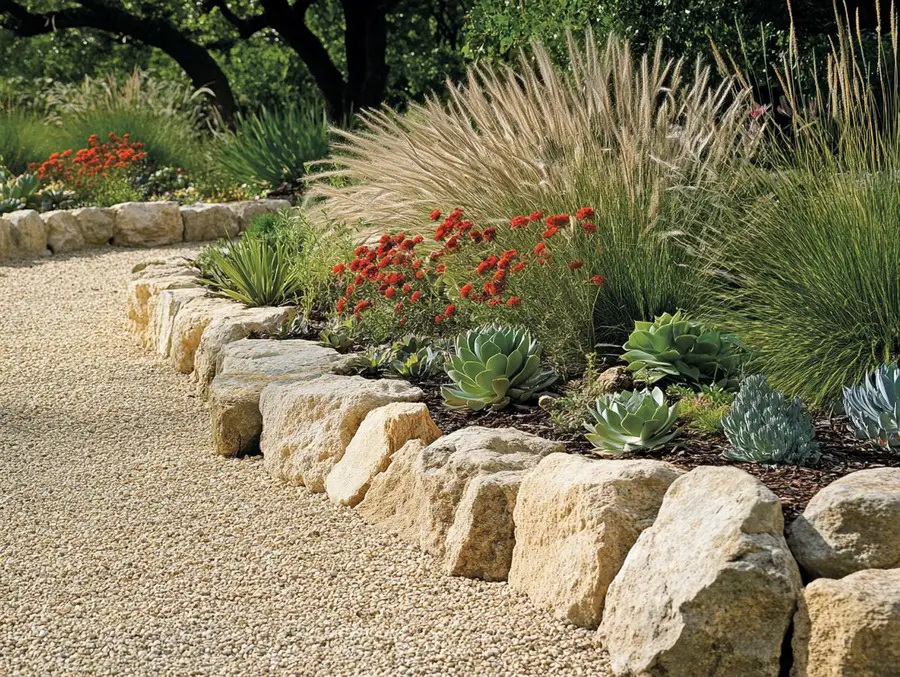
Edging and Borders in Xeriscaping can give your outdoor space a polished, cohesive look while serving practical purposes like weed control and soil retention.
A well-designed xeriscape garden isn’t just about plants, it’s also about structure and definition.
The right materials and design choices make a big difference in aesthetics and function, helping you create a landscape that thrives with minimal water.
Edging and Borders in Xeriscaping Key Takeaways
- Edging and Borders in Xeriscaping define garden spaces, prevent soil erosion, and enhance visual appeal.
- Popular options include natural stone, metal, and mulch borders, which help retain moisture and minimize weed growth.
- Choosing the right materials can boost water efficiency while keeping your xeriscape looking neat and organized with minimal upkeep.
Edging and Borders in Xeriscaping: Define & Beautify
Xeriscaping is a fantastic landscaping approach that helps you conserve water while still creating beautiful outdoor spaces.
In this article, you’ll explore the important role of edging and borders in xeriscaping, and how these elements can enhance both the look and functionality of your garden.
You’ll discover a variety of materials and design options that match your style, and a step-by-step guide to help you incorporate these features into your landscape.
Don’t worry. There are also essential maintenance tips included to keep your borders thriving over time.
Get ready to transform your garden into a stunning, water-efficient oasis!
What are Edging and Borders in Xeriscaping?
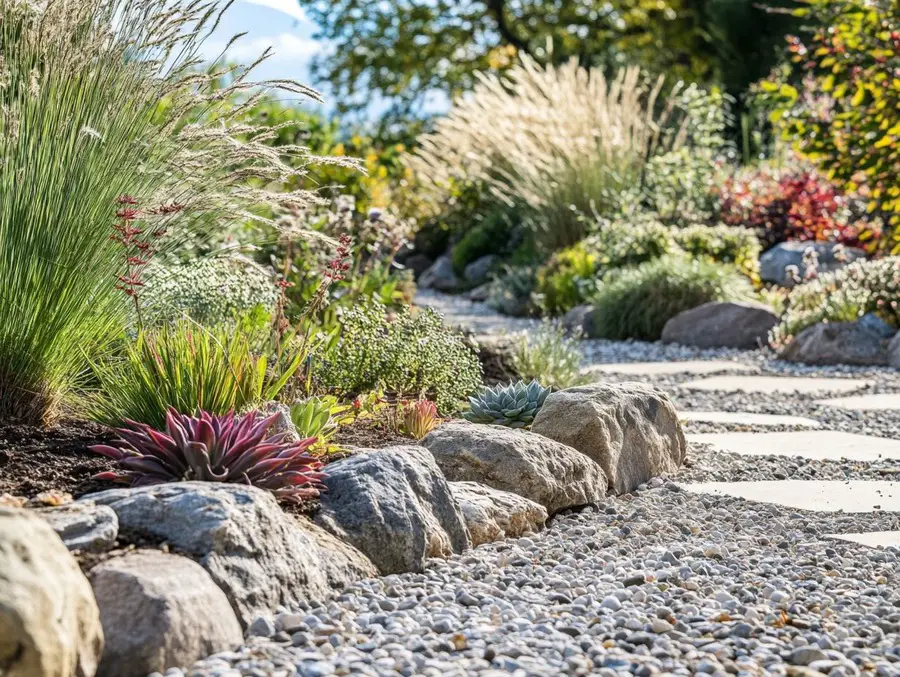
Xeriscaping is a fantastic way to create a sustainable landscape that focuses on using drought-tolerant plants and eco-friendly materials.
It helps you craft beautiful outdoor spaces while conserving water.
This thoughtful approach boosts biodiversity and soil health and cuts down on the environmental impact of traditional gardening methods.
When you focus on native habitats, xeriscaping encourages you to choose plants that are perfectly suited for your local climate, which means you won’t need to drown them with excessive irrigation.
These well-chosen species generally require less maintenance, making them a great option if you’re looking to simplify your gardening routine.
The principles of xeriscaping also suggest using efficient irrigation methods, enhancing soil quality, and placing plants strategically to maximize water efficiency.
By adopting this landscaping strategy, you’re not just practicing sustainable gardening; you’re also making your outdoor spaces more resilient against the impacts of climate change.
Benefits of Edging and Borders in Xeriscaping
When you incorporate edging and borders into your xeriscaping project, you’re not just making your garden look good.
You’re also adding some serious benefits.
These elements help with soil retention, keep weeds at bay, and make maintenance a lot easier.
They create visual boundaries that guide your landscaping layout while adding texture and seasonal interest to your outdoor space.
It’s a win-win for both functionality and aesthetics!
Enhancing Aesthetics and Functionality
You can enhance both the beauty and functionality of your xeriscaping by using some smart design principles.
Think about how borders and edging can really tie your garden together, making it visually appealing and practical.
This approach doesn’t just prettify your outdoor space as it also helps promote ecological balance and manage vegetation effectively.
By thoughtfully arranging different plant varieties that thrive in specific microclimates, you can create a landscape that looks stunning all year round.
Consider using shapes and textures that complement your surroundings.
This will elevate your garden’s aesthetics, transforming it into a serene retreat rather than just a space for drought-resistant plants.
For seasonal interest, mix in some flowering perennials with drought-tolerant foliage.
This way, there will always be something eye-catching to admire.
By blending beauty with purpose, you can turn any outdoor area into a harmonious haven that supports native biodiversity while meeting the practical needs of low-water gardening.
Types of Edging and Borders
You have a bunch of options when it comes to edging and borders for your xeriscaping project.
You can choose traditional materials like decorative stones and rock borders, or go for more sustainable choices like organic mulch and permeable surfaces.
Each of these options comes with its own set of benefits, enhancing both the functionality and the look of your outdoor space while also helping with water conservation and keeping your soil healthy.
Edging Materials and Design Options
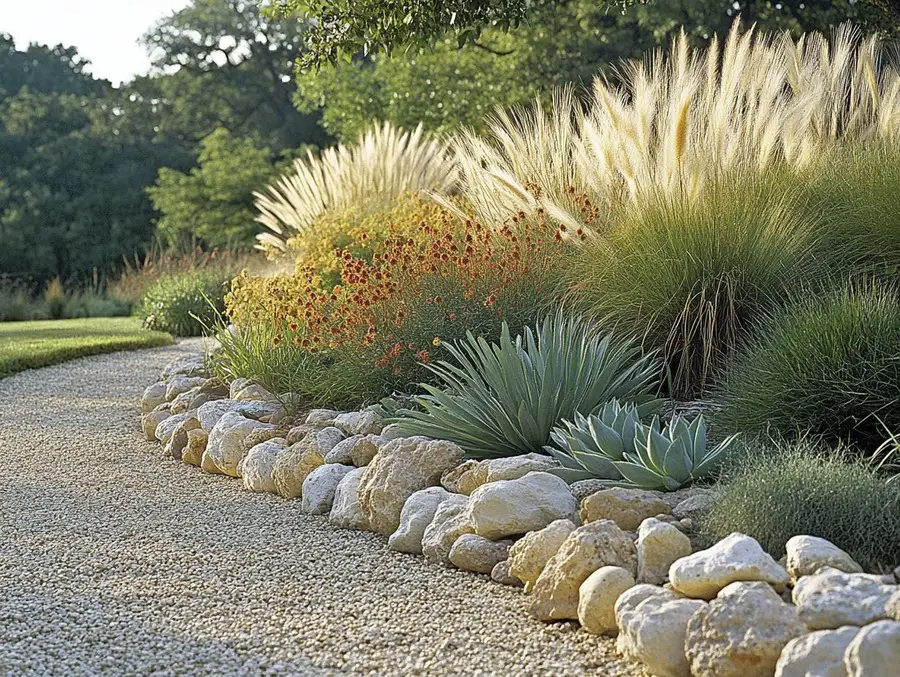 When you’re picking materials and design options for edging and borders in your xeriscaping, think about using eco-friendly materials that enhance your garden layout and also support sustainable practices.
When you’re picking materials and design options for edging and borders in your xeriscaping, think about using eco-friendly materials that enhance your garden layout and also support sustainable practices.
From organic mulch to decorative stones, each choice can help you create a visually stunning and environmentally responsible outdoor space.
For starters, consider using recycled rubber or composite lumber.
They make durable, long-lasting borders that blend right in with natural landscapes while helping to retain soil amendments and moisture.
You might also want to look into landscaping fabric made from biodegradable materials.
It’s a smart choice for suppressing weeds and promoting healthy drainage, making your garden more accessible no matter the type.
Natural stones like river rocks are another fantastic option.
They give a beautiful edge and also bring stability and support to your xeriscaped garden.
They help manage water runoff and elevate the overall aesthetic of your landscape.
Ultimately, it’s all about choosing materials that meet your functional needs while aligning with the principles of sustainability and eco-conscious gardening.
How to Incorporate Edging and Borders in Your Xeriscaping
When you incorporate edging and borders into your xeriscaping, it’s all about strategic planning and execution.
You want to make sure they boost both the looks and functionality of your garden layout.
By keeping in mind things like irrigation, drainage, and plant selection, you can create a beautiful and sustainable landscape that really thrives in its environment.
Step-by-Step Guide
A step-by-step guide to installing edging and borders in your xeriscaping can help you achieve that perfect look while also maximizing functionality.
When you follow best practices for plant placement and landscape design, you can create borders that catch the eye and support your sustainable gardening goals.
To kick things off, gather the tools you’ll need—think a spade, a straight-edge shovel, and some sturdy gloves.
- Start by planning your design. Sketch out how you want things to look, keeping in mind plant groupings for optimal growth and visual appeal.
- Next, measure the area where you want to install the edging, making sure it’s easy to access for any maintenance later on.
- Then, dig a trench that’s just right for your chosen edging material—whether it’s stone, metal, or plastic—and be sure to keep it level for that polished finish.
- As you’re working, don’t forget to add in drought-resistant plants for your borders. They’ll thrive in xeriscape conditions and need minimal watering.
- Lastly, keep maintenance in mind. Make sure there’s enough space for good air circulation and easy access for weeding.
Maintenance and Care for Edging and Borders
Taking care of your edging and borders is key to making sure they last and look great in your xeriscaping project.
By regularly keeping an eye on weed control, making soil amendments, and adjusting things seasonally, you’ll help maintain the visual appeal and functionality of your garden borders.
Tips for Longevity and Preservation
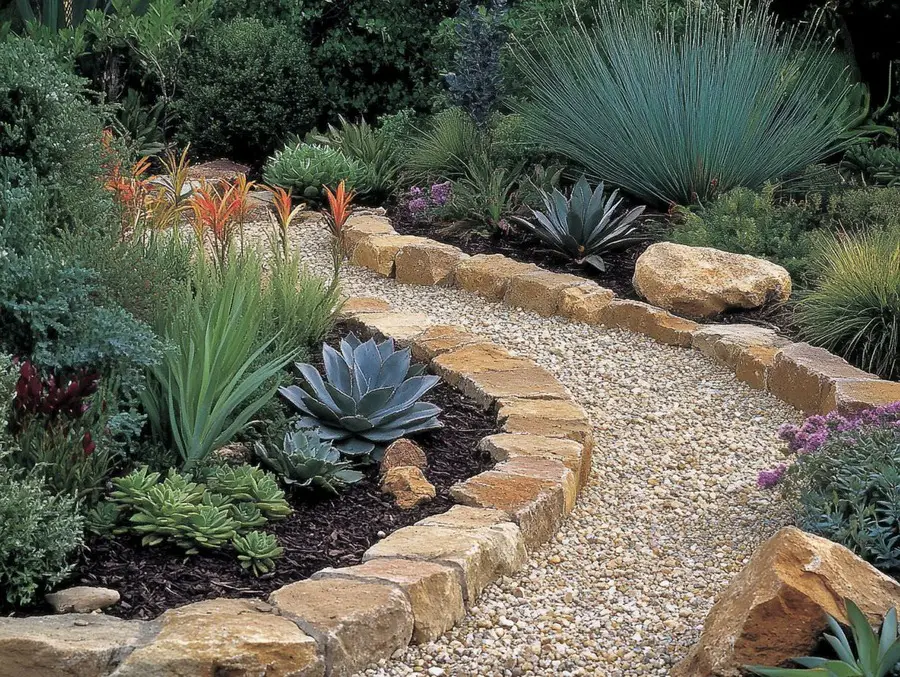
When you implement effective tips for the longevity and preservation of your edging and borders, you’ll significantly enhance both the durability and aesthetic appeal of your xeriscaping.
Using organic mulch, choosing the right materials, and planning for seasonal interest will help keep your garden vibrant and functional.
Incorporating native plant species is a win-win; it promotes ecological landscaping and boosts local biodiversity, creating a harmonious environment.
Regular maintenance, like trimming and reinforcing your borders, is key to preventing erosion and effectively marking different garden areas.
Don’t forget to adjust your edging care routine with the changing seasons.
For instance, applying fresh organic mulch in spring fosters healthy soil and protects against weeds.
Ultimately, these thoughtful strategies will help you cultivate a resilient garden space that stands the test of time, offering beauty and ecological benefits all year round.
Edging and Borders in Xeriscaping FAQs
What is the purpose of edging and borders in xeriscaping?
Edging and borders serve multiple purposes in xeriscaping, including defining and separating different areas of the landscape, preventing erosion, and keeping weeds and grass from encroaching on the xeriscaped areas.
What materials are commonly used for edging and borders in xeriscaping?
Some common materials used for edging and borders in xeriscaping include stone, brick, metal, and plastic.
These materials are durable and can withstand the harsh conditions of a xeriscaped landscape.
Do I need to use edging and borders in my xeriscaped garden?
While not necessary, edging and borders can greatly enhance the appearance and functionality of a xeriscaped garden.
They can help create structure and organization, as well as protect the landscape from unwanted growth.
Can I use plants as edging or borders in xeriscaping?
Yes, using plants as edging and borders can add a natural and aesthetic touch to a xeriscaped garden.
Low-growing plants such as succulents, ornamental grasses, and groundcovers can be used to define and separate different areas.
How do I maintain edging and borders in xeriscaping?
Regular maintenance of edging and borders is important to ensure their effectiveness and longevity.
This may include replacing damaged materials, removing debris and weeds, and trimming plants used as borders.
Can I add edging and borders after I have already xeriscaped my garden?
Yes, edging and borders can be added at any time, even after the main xeriscaping work is done.
This can be a great way to refresh the look of your garden and provide additional structure and organization.
Xeriscape Garden Design & Layout: Easy Water-Wise Beauty
What is xeriscaping? A beginner’s guide to drought-tolerant landscaping
Related Content
Visit my Amazon Influencer Page for videos and gardening products Grow Your Own Garden

